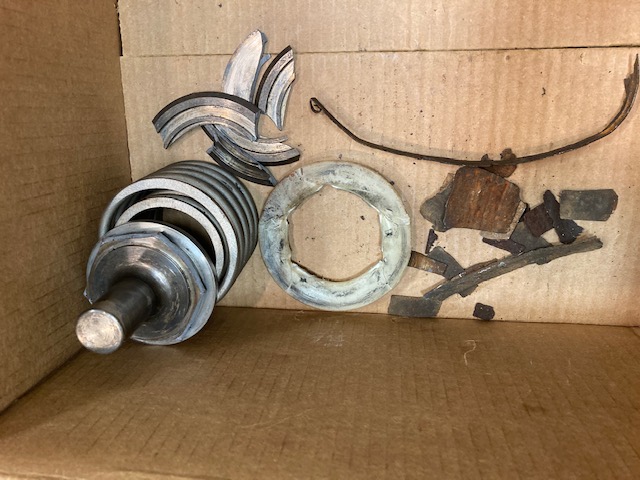Your reciprocating pump’s efficiency is only as good as each parts ability to function correctly. Focusing on the plunger pump valves, below are 3 possible causes of why your valves are not lasting as long as they should.
Incorrect Valve for Application
Choosing the correct valves for your pump is the first step for ensuring a long life for your valves. You’ve heard “A valve is a valve is a valve.”, but that’s not true. There are many different valves available that are designed specifically for the various conditions out in the field and some can be customized to fit your exact need.
In other cases, the valves may be correct for the intended media but damaged by unforeseen issues such as scale from inside the tank (as seen in below photo of a valve with broken disc, battered insert, and the media that caused the damage). Pumps with this issue would benefit from a suction line filtration system to prevent this media from interacting with and causing deterioration of the valve.

Valve with broken disc, battered insert and the media that caused the damage.
Neglecting Maintenance
Regularly scheduled maintenance is one of the best ways to achieve peak performance from your valves, whether they are in the pump or pipeline. Recognizing the early warning signs of wear and tear on less expensive items such as the locknut, bolt, sleeve, spring, or valve disc during routine inspections of a pump valve can greatly diminish the need to replace the entire valve, which saves money.
Yes, regular maintenance precipitates pump downtime, which temporarily decreases production and revenue, however omitting it can lead to costlier failures like contamination, emergency shutdowns, and/or complete pump failure.
Sometimes even when regular maintenance is done, pump mechanics are pressured to “get it done yesterday” which almost always creates a “fire” situation and leads us to our next cause of inadequate longevity in valves.
Insufficient Training and/or Improper Valve Installation
Proper installation is key to your valve’s efficiency and life expectancy. Providing the training that demonstrates the correct techniques to use during installation will lead to better habits and result in a much better outcome than if you let them “just figure it out” for themselves.
More often the valve installation training is left to the previous mechanic who may be passing on a shortcut or other bad habits he has developed due to the pressure of getting the valve(s) replaced “yesterday”. Some of these shortcut/bad habits include:
- Not cleaning the pump ports prior to installation. If the ports are not free of foreign matter, rust, or corrosion, the valve seat will not fit accurately in the port and that increases the chance for the valves to pop out of place, which is when some mechanics resort to:
- Back-pumping. This involves running the pump backwards, so the suction forces the valve into place. Not only is the process detrimental to the reciprocating pump, which is not designed to run backwards, it may also cause the valve to seat so tightly that it may be next to impossible to remove the valve when it becomes necessary to do so.
- Using a sledgehammer (or two) directly on a valve. There is never a need to deliver a heavy blow directly to the valve to get it to seat in the port. Some valves that can normally sustain 40 tons of straight pressure may not be able to survive this fast, hard blow. And even if they do, using a sledgehammer could void your valve warranty and also hinder the ability to remove the valve when the actual replacement time comes. Light tapping on the pressing (or wood) block or seat wrench (fitted over the stud) with a hammer or mallet will sufficiently “home” the valve seat and then the pump action will seat the unit precisely and firmly by equalized liquid pressure.
Conclusion
As with most things, it all comes down to time and money. By not choosing the correct valve in the first place, neglecting regular maintenance, and supplying insufficient training that leads to improper valve installation, you will be setting yourself up for spending more time and money in the future addressing the problems that arise from them.
At Triangle Pump Components Inc, we have over 100 years of experience and expertise to help select the correct valve for your application and solve any reciprocating pump problem. Contact us today!